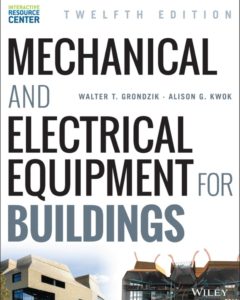Mechanical and Electrical Equipment for Buildings 12 Edition
Mechanical and Electrical Equipment for Buildings 12 Edition
Mechanical and Electrical Equipment for Buildings 12 Edition written with the student, the architect‐ or engineer‐in‐training, and the practicing professional in mind. Basic theory, preliminary design guidelines, and detailed design procedures allow the book to serve both as an introductory text for the student and as a more advanced reference for both professional and student. This work is intended to be used as a textbook for a range of courses in architecture, architectural engineering, and building/construction management.
Digital control systems has encouraged this trend. Further encouragement comes from multipurpose buildings whose schedules of occupancy are fragmented and from corporations with varying work schedules that result in partial occupancy on week-ends. Another factor in this move to decentralization is worker satisfaction; there is increasingly solid evidence that productivity increases with a sense of individual control of one’s work environment. Residences are commonly being used as office work environments. Expanding communications networks have made this possible. As residential designs thus become more complex (with office‐quality lighting, zones for heating/cooling, sophisticated communications, noise control), our nonresidential work environments become more attractive and individual.
You can also Read Mechanical and Electrical Equipment for Buildings 11th Edition
Mechanical and Electrical Equipment for Buildings 12 Edition Content
- THE BUILDING DESIGN CONTEXT
![Mechanical and Electrical Equipment for Buildings]()
- DESIGN Fundamentals
- PASSIVE ENVIRONMENTAL SYSTEMS
- ACTIVE ENVIRONMENTAL SYSTEMS
- ACOUSTICS
- FIRE PROTECTION
- ELECTRICITY
- SIGNAL SYSTEMS
- TRANSPORTATION
- A:Metrication, SI Units, and Conversions
- B:Climatic Conditions for the United States, Canada, and Mexico
- C:Solar and Daylighting Design Data
- D:Solar Geometry
- E:Thermal Properties of Materials and Assemblies
- F:Ventilation and Infiltration
- G:Heating and Cooling Design Guidelines and Information
- H:Standards/Guidelines for Energy- and Resource-Efficient Building Design
- I:Annual Solar Performance
- J:Economic Analysis
- K:Sound Transmission Data
- L:Design Analysis Software
A rapidly increasing interest in green design on the part of clients and designers may help to mitigate such problems, although green design is hopefully just an intermediate step in the journey to truly sustainable solutions. And no, we are not designing sustainable solutions today—despite the claims about sustainable this and sustainable that which fill the Internet, conference presentations, and professional journals.


Comments are closed.